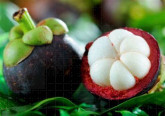Viability of α-mangostin and Lipopolysaccharide (LPS) in 7F2 Cells http://www.doi.org/10.26538/tjnpr/v7i1.22
Main Article Content
Abstract
Based on data from RISKESDAS in 2018, the incidence of tooth extraction in Indonesia is 19%. In post-extraction of teeth, the gingival tissue around the extraction area is inflamed as well as a decrease in the dimensions of the alveolar ridge. Socket preservation is performed to reduce the possibility of bone resorption and bone formation. Alpha(α)-mangostin from mangosteen peel extract (Garcinia mangostana Linn.) is expected to accelerate post-extraction healing so that implant placement can be more adequate. The study analyzed the viability of α-mangostin and lipopolysaccharide on 7F2 cells lines. Microtetrazolium (MTT) assay against 7F2 cell culture was used. The correlation between concentration and viability of Lipopolysaccharide (LPS) and α- mangostin was interpreted by statistical analysis. The viability of the 7F2 cell culture increased in line with the increase in the concentration of α-mangostin and the optimal concentration of 8.25 g/mL with the highest percentage of living cells at 132.120%. α-mangostin can increase the viability of 7F2 cell culture and it has the potential to be used as an alternative material to reduce inflammation after tooth extraction.
Downloads
Article Details

This work is licensed under a Creative Commons Attribution-NonCommercial-NoDerivatives 4.0 International License.
References
Riset Kesehatan Dasar. Laporan Nasional Riskesdas 2018. Badan Penelitian dan Pengembangan Kesehatan Riset. 2018.
Maulana EG, Adhani R, Heriyani F. Faktor Yang Mempengaruhi Kehilangan Gigi Pada Usia 35-44 Tahun Di Kecamatan Juai Kabupaten Balangan Tahun 2014 Tinjauan Terhadap Pengetahuan Dan Sosial Ekonomi. Dentino: J Ked Gigi. 2016;1(1):98-103.
Nardiatmo SP, Mappangara S, Jais AI. Mempertahankan soket setelah pencabutan gigi: tinjauan sistematik. Makassar Dent J. 2019;8(2):91-6.
Juodzbalys G, Stumbras A, Goyushov S, Duruel O, Tözüm TF. Morphological classification of extraction sockets and clinical decision tree for socket preservation/augmentation after tooth extraction: a systematic review. J Oral Maxillofac Surg. 2019;10(3):1-12.
Fee L. Socket preservation. British Dent J. 2017;222(8):579-82.
Gutierrez-Orozco F, Chitchumroonchokchai C, Lesinski GB, Suksamrarn S, Failla ML. α-Mangostin: anti-inflammatory activity and metabolism by human cells. J Agricul Food Chem. 2013;61(16):3891-900.
Larsuprom L, Rungroj N, Lekcharoensuk C, Pruksakorn C, Kongkiatpaiboon S, Chen C, Sukatta U. In vitro antibacterial activity of mangosteen (Garcinia mangostana Linn.) crude extract against Staphylococcus pseudintermedius isolates from canine pyoderma. Vet Dermatol. 2019;30(6):487-e145.
Fu T, Li H, Zhao Y, Cai E, Zhu H, Li P, Liu J. Hepatoprotective effect of α-mangostin against lipopolysaccharide/d-galactosamine-induced acute liver failure in mice. Biomed Pharmaco. 2018;106:896-901.
Hafeez BB, Mustafa A, Fischer JW, Singh A, Zhong W, Shekhani MO, Meske L, Havighurst T, Kim K, Verma AK. α-Mangostin: a dietary antioxidant derived from the pericarp of Garcinia mangostana L. inhibits pancreatic tumor growth in xenograft mouse model. Antiox Redox Sig. 2014;21(5):682-99.
Li D, Liu Q, Lu X, Li Z, Wang C, Leung CH, Wang Y, Peng C, Lin L. α-Mangostin remodels visceral adipose tissue inflammation to ameliorate age-related metabolic disorders in mice. Aging (Albany NY). 2019;11(23):11084.
Tatiya-Aphiradee N, Chatuphonprasert W, Jarukamjorn K. Anti-inflammatory effect of Garcinia mangostana Linn. pericarp extract in methicillin-resistant Staphylococcus aureus-induced superficial skin infection in mice. Biomed Pharmaco. 2019;111:705-13.
Lim YK, Yoo SY, Jang YY, Lee BC, Lee DS, Kook JK. Anti-inflammatory and in vitro bone formation effects of Garcinia mangostana L. and propolis extracts. Food Sci Biotech. 2020;29(4):539-48.
Idrus E, Kiswanjaya B. Mangosteen extract inhibits LPSinduced bone resorption by controlling osteoclast. J Inter Dent Med Res. 2016;9:362-6.
Chen G, Deng C, Li YP. TGF-β and BMP signaling in osteoblast differentiation and bone formation. Inter J Bio Sci. 2012;8(2):272-8.
Zhang W, Jiang G, Zhou X, Huang L, Meng J, He B, Qi Y. α-Mangostin inhibits LPS-induced bone resorption by restricting osteoclastogenesis via NF-κB and MAPK signaling. Chinese Med. 2022;17(1):1-3.
Sondhi P, Maruf MH, Stine KJ. Nano Biosens Lipo: Biosensors. 2019;10(1):2-4.
Farhana A, Khan YS. Biochemistry, lipopolysaccharide. InStatPearls 2021 Apr 29. StatPearls Publishing.
Lestari C, Darwin E, Putra DP, Suharti N. The α-mangostin effect on the quantity of TGF-β1 titer relate to the mandibular bone volume of Rattus novergicus in the periodontitis model. J Pharm Pharmacog Res. 2021;9(5):609-18.
Kresnoadi U, Ariani MD, Djulaeha E, Hendrijantini N. The potential of mangosteen (Garcinia mangostana) peel extract, combined with demineralized freeze-dried bovine bone xenograft, to reduce ridge resorption and alveolar bone regeneration in preserving the tooth extraction socket. J Indian Prostho Soc. 2017;17(3):282-5.
Huang Z, Kraus VB. Does lipopolysaccharide-mediated inflammation have a role in OA?. Nature Rev: Rheumatol. 2016;12(2)


